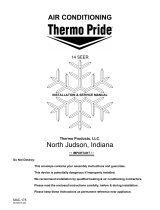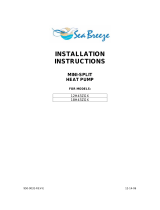
Table 6-2 Piston size
and humidity control depend on the correct balance between indoor load and outdoor unit capacity. High
Air conditioning requires a specified air flow. Each ton of air conditioning requires 400 cubic feet of air
per minute (400CFM/TON).
of 3°in the return duct and 4°in the supply duct. This can reduce the cooling capacity of an air
conditioning system by as much as 30%.This means a loss of almost one ton of cooling capacity from a
three ton system.
Air leakage of only 3% in a return duct can cause a 5% loss in system capacity. 3% leakage on a three
Duct systems installed in the conditioned space can be left uninsulated , but a dense 1/2” fiberglass duct
liner reduces blower and air noises, and prevents sweating ducts when humidity levels are high.
Supply and return duct systems in attics and crawl spaces require a minimum 1” of dense duct liner or 2”
fiberglass wrap with a sealed vapor barrier. A leaky vapor barrier results in duct sweating, causing wet
Air supply diffusers must be selected and located carefully. They must be sized and positioned to deliver
! WARNING
adjustment and operation of this unit. Read these instructions thoroughly before attempting installation or
P
iston sizes and indoor fan speed:
Note: the piston placed in the outdoor unit package box is used for indoor unit when cooling
.
The air distribution system has the greatest effect. On the quality of the installation and the owner satisfaction,
The correct air quantity is critical for correct air conditioning system. Proper operation, efficiency, compressor life
performance and customer's satisfaction and can cause premature component failure.
Duct design and construction should be done with care. System performance can be lowered
Effective duct insulation is essential to prevent loss of capacity and sweating ducts in the cooling mode.
dramatically through bad planning or workmanship. In cooling, a hot attic can cause a temperature gain
ton system is only 30 CFM. Two or three unsealed joints can cause a leak of this size. Sealing the return
and supply ducts result in full system capacity and lower operating costs.
the duct system is totally in the responsibility of the contractor. These are numerous thchnical associations
Low indoor air flow reduces total capacity, and can causes coil icing. Improper air balance will affect system
and reference that recommend correct procedures.
indoor air flow reduces system dehumidification capacity, and can leave the space humid and uncomfoltable.
Heat transfer through poorly insulated systems can result in over 50%
insulation
does not insulated.
loss in operating capacity. Sweating
ducts also results in rusting that leads to premature duct failure. Carefully follow the industry practices to
7. REFRIGERANT SYSTEM DIAGRAM refer Figure 7
insure a well designed duct system.
treated air along the perimeter of the space. If they are too small for their intended air flow, they can be
noisy. If they are not located properly, they can cause drafts in the rooms. Return air grilles
must be
properly sized to carry air back to the blower. If they are too small they also cause noise. The installers
ensures a comfortable living space.
8. INSTALLATION INSTRUCTIONS
should balance the air distribution system to ensure proper air flow to all rooms in the home. This
These instructions are intended as an aid to qualified, service and instalolation personnel for proper installation
,
service this equipment. Failure to follow these instructions may result in improper installation,
service or maintenance and could possibly result in fire, electrical shock, property damage.
13
a
AAa
H andler model
Outdoor Indoor
Piston Size
(Installed in
outdoor)
Piston Size
(placed in
package bag)
Indoor fan
speed
HR18D2VAR HB2400VD1M20 051 057 M
HR24D2VAR HB2400VD1M20 057 062 H
HR30D2VAR HB3600VD1M22 059 071 L
HR36D2VAR HB3600VD1M22 062 078 H
Central Air Conditioning Model: Heat Pump, HR13-D2






















